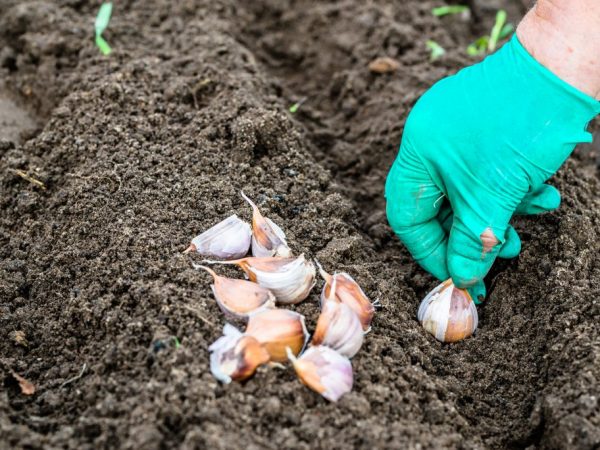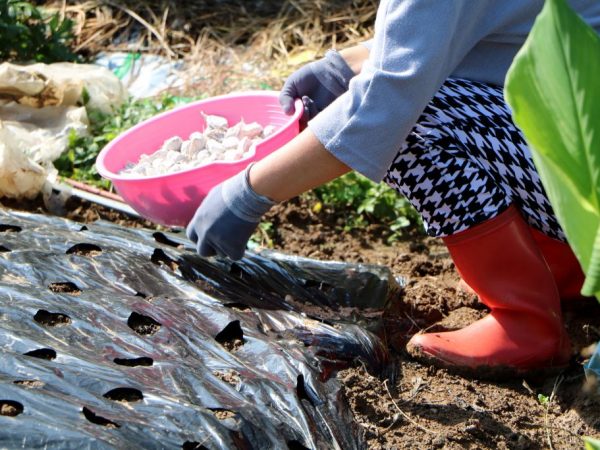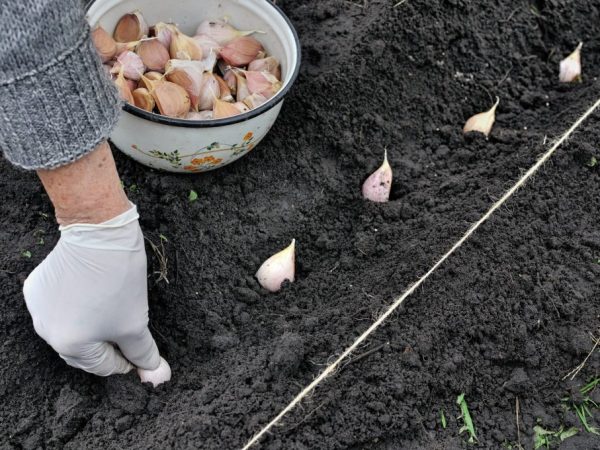Rules for planting garlic cloves before winter
Most gardeners grow garlic in their garden. This plant contains beneficial vitamins and minerals. It is grown using seeds, bulbs or cloves. Each method has its own nuances, so not everyone knows how to plant garlic with cloves.

Planting garlic cloves before winter
The onion plant is traditionally planted 2-3 weeks before frost. This is how winter garlic adapts to external conditions. In the middle lane, this is done between the beginning of September and mid-October. In other areas, they are guided by the temperature. If it dropped to 10 degrees at night, then it’s time to plant the plant.
Choosing a landing site
Soil with low to normal acidity is ideal for planting garlic before winter. The garden bed should be on the sunny side.
Before growing, you should pay attention to which crops used to grow in the ground. Good precursors for winter garlic are:
- early cabbage;
- zucchini;
- pumpkin;
- cucumbers;
- tomatoes;
- legumes, etc.
It is allowed to plant an onion plant near horticultural crops (strawberries, strawberries). It is not recommended to grow garlic after potatoes and onions. Similar diseases can accumulate in the soil. Subsequently, they can have a negative impact on the yield of the vegetable.
The basic rule is not to plant garlic in one place for more than 2 years in a row. Otherwise, the soil becomes infected with stem nematode. Before planting another crop, it requires long processing.
Preparation for growing
Preparation is an important step in growing plants. Helps to determine the possible causes of the death of garlic in the past years. Therefore, before planting, the soil and teeth should be carefully inspected.

Be sure to prepare the garlic for planting
Soil preparation
Starts at the end of August. To begin with, the land is checked for pests and diseases. If they have been identified, soil fertilization is necessary. You will need 10 grams of humus, a glass of chalk and 300 grams of ash. This is enough for 1 m2.
Some gardeners add 2 tablespoons of potassium sulfate and 1 tablespoon of superphosphorus. All components are mixed and evenly distributed on the soil. After that, the garden bed is dug up to 20-25 cm.
An important rule is that it is not recommended to fertilize the soil with manure. It will increase the acidity and the amount of peat in the ground. This will negatively affect the germination of the vegetable. The soil is left for 15-20 days before planting. This is necessary so that the soil does not settle.
If you plant garlic immediately after digging, the yield will decrease. During the subsidence of the earth, the teeth will also sink down. In spring, germination time will increase by 1-2 weeks, the plant heads will be small.
Preparing the cloves
We divide the head of garlic into cloves without fail before planting. Each must be examined and only healthy and large seed material must be selected. The scales should not be damaged.
It is not recommended to use teeth with mold and rot spots.The entire surface should be free of dents and scratches. Selected cloves require processing. A solution of potassium permanganate and copper sulfate is perfect. Seed material is soaked for 10-12 hours.
An important note - the cloves must be dried. If they are wet, the quality of the crop will be quite low.
Ash solution treatment
- you need 2 glasses of wood ash;
- fill it with 2 liters of warm water;
- after 3-5 hours the ash will dissolve in water;
- after stratification of the solution, use the light part.
Some growers use a saline solution to prepare the cloves. You will need 5 tablespoons of salt in a bucket of water. Lower the cloves for 10-20 minutes. They are planted on the garden bed without washing.
Landing
To begin with, form the beds. The optimal size is 0.25 * 1 m. In them, holes are made with a depth of 5 to 15 cm. If the planting time is 2 weeks before the first frost, then the depth does not exceed 5 cm. In the middle lane, this is the period from September 23 to October 15. In regions with a warm climate - early November.
If a gardener is going to plant garlic for the winter in advance (at the end of August - at the beginning of autumn), then the depth is 10-15 cm. Thanks to this, the teeth will tolerate frost well and take root.
Some gardeners use the rule - the planting depth is equal to the height of the clove, multiplied by 2. That is, if the length of the clove is 5 cm, then it is planted to a depth of 10 cm.
The distance between the holes is 10 cm. This is necessary so that the teeth do not interfere with each other's growth. The optimal distance between the rows is 25-30 cm. This will allow you to easily carry out the basic care procedures: loosening, weeding, fertilization.
Remember that you do not need to press the teeth into the ground. This can damage the formation of the root system.
Maintain the distance
Landing grooves
Another planting method, which consists in the fact that a layer of clean sand is poured on the bottom. Thus, the teeth are protected from decay.
After planting, the soil is mulched. This is a mandatory procedure aimed at frost protection. But if the region has a warm climate, then mulching can be skipped. Dry peat or sawdust are suitable as mulch. The mulch layer should not be less than 3 cm.
If there is no snow in winter, then it is necessary to cover the bed with plastic oilcloth. In the spring, it is harvested after the frost has retreated. The crop is harvested in the middle of summer - in late July or early August.
Garlic care
If you plant the garlic correctly, then the care will be minimal. It consists of watering, fertilizing and pest control.
If the organic matter of the soil is poor, apply phosphorus fertilizers before planting. You need 1 tablespoon of superphosphate, 500 ml of wood ash and 2-3 tablespoons of potassium sulfate to dissolve in a bucket of water. Fertilizers are best applied by drip irrigation.
In the spring, when the frost passes, the main remedy is urea. Dissolve 1 tablespoon of urea in 1 bucket of water. Water the seedlings with a solution.
Watering is carried out every 7-10 days. The ground should not be too wet or dry. Be sure to clear the weeds from the garden. They spoil the root system of the onion plant.
The best varieties for planting for the winter
When choosing a variety of garlic, each gardener is guided not only by personal preferences.
It takes into account soil quality, weather and climatic conditions, planting time and early maturity.
The most popular varieties of garlic, which are planted with cloves before winter:
- Otradnensky. It is characterized by resistance to low temperatures and pests. Has a high yield (1.5 kg per 1 m2). It is medium late and has a spicy taste. Suitable for growing in Ukraine, Belarus, Russia.
- Gribovsky 60 - early maturing, glassy. Head weight - about 50 g. The number of cloves is from 6 to 12. The taste is excellent.
- Gribovsky jubilee. Ripening period is medium late. Suitable for growing in the middle lane. Resistant to drought, frost and waterlogging.
- Komsomolets. The growing season lasts no more than 110 days. Has a pungent taste.Produces a good harvest if all planting requirements have been met.
- Danilovsky local. Recommended for growing in the middle lane. Bulb weight - about 45-50 gr. The taste is less pungent than other varieties. Productivity - 1-1.2 kg / m2.
All varieties are suitable for conservation. Can be used raw. After drying, they are added to spices.
Conclusion
Planting garlic with cloves is easy. The main thing is the correct preparation of the soil and seed material. If there are suspicions about the quality of the soil or teeth, it is better to check and process them.
Winter garlic should be planted in mid to late autumn. It must take root. The main care operations are watering once a week, mulching for the winter, fertilizing in autumn and spring. If all the requirements are met, the garlic will yield an excellent harvest.



